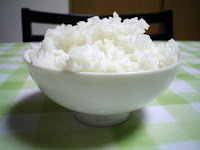
Rice is great for a food budget. First, rice is cheap. Once cooked, it feeds a lot - you get a lot of bang for your buck.
Plus, rice is easy to prepare and to store. You can also freeze rice by itself, along with most rice recipes (depends on the other ingredients). It can be savory or sweet; a side dish or an entree or a dessert.
Brown rice, or whole-grain or wild rice is very nutritious - much more so than the more familar white rice versions. Put rice with beans, and you create a complete protein, too.
Basic Rice Recipe -- How to Cook Rice
1. Rinse your rice 2-3 times before it goes into the pot. This gets rid of excess starch on the kernels, helping to prevent sticky rice as well as rice stuck and burned on the bottom of the pan.
2. If you have time, soak your rice in some water. Makes it plumper on the plate. This is really a must for whole grain (brown) rice -- soak it for a couple of hours, makes a big difference.
3. Don't use that Minute Rice or Precooked stuff. You don't need it, it doesn't taste as good, has less nutrition, and costs more.
4. Use a pot that has a tight fitting lid (steam is crucial to cooking rice) and a nice heavy construction. Me, I like my ceramic-covered cast iron pot ....
5. Some say not to salt or butter the rice while it's cooking. I ignore them. I salt the boiling water, and I add a couple of tablespoons of butter, or olive oil, for taste. I might throw in a garlic clove on a whim. You get the idea. Depends on what I'm using the rice for -- olive oil, for example, isn't really good if I'm going for a dessert if you know what I mean.
6. Older rice takes longer to cook than fresh rice. It's doable, though, just needs more time in the pot. Best if you've stored your rice in a tight jar in the pantry (air tight).
7. How much water? Put in 1.5 cups of water (one and a half cups) for each cup of white rice, 2.5 cups for wild rice. Yes, you can substitute stock for this - chicken, pork, whatever.
8. Put the rice and water on the stove and bring it to a boil over medium heat. (Some folk put whole grain rice into a hot, dry skillet and let it "fry" for a bit before combining it with the water - I might do this if I have time, and I always do this if I'm making Spanish Rice because it adds a little crunch to the dish.)
9. Add the butter and salt.
10. Turn the heat down to low and put the lid on tight.
11. After about 15 minutes, check the white rice. If it looks done, there's no liquid in the pot, and there are little holes that have popped up on the surface, you're done. Whole grain, or wild rice, takes a lot longer because it hasn't had its outer covering stripped away. It's going to take about 45 minutes to cook.
12. Remember, it's not criminal to pop up that lid and check on things - particularly when you're just getting started here. Sure, steam will escape but that's not going to be the end of the world. Stir the rice around, check your liquid levels -- if it's even hinting at burning on the bottom, you've got the heat too high.
13. Key to rice: low heat and patience.
14. Cheap, frugal rice dishes? Chicken and Rice, Broccoli Rice Casserole, Chicken Fried Rice, Spanish Rice, Rice Pudding, Rice-Stuffed Bell Peppers, Rice and Bean Cakes, and any sort of Chinese Stir Fry with veggies on hand come to mind ... rice is used a lot around here.
15. For more rice recipes, surf around these sites and see what tickles your fancy:
Recipes.LovetoKnow.Com - Rice
All Recipes.Com - Rice
16. Don't forget the chop sticks!!! Rice is the great excuse to use them - makes for a fun meal.
